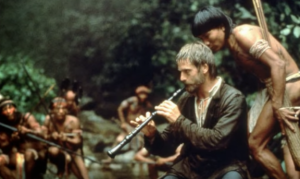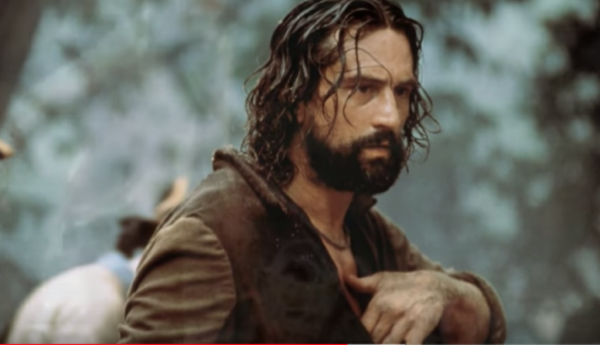The Mission (1986): A Model for Character Building

The Mission a 1986 feature film directed by Roland Joffé that was both a critical and commercial success. It has an amazing soundtrack by Ennio Morricone, a brilliant cast (Jeremy Irons, Ray McAnally, and Robert De Niro), Oscar-winning cinematography, and great costume design. It’s also a good portrayal of history.
The overall plot–Jesuit missions in South America–is shown with great accuracy. One of the most well-known aspects of these missions was their communal organization. They’re often compared to socialist settlements, and that made them very suspicious to other people during their time.
Jesuit Reductions in The Mission
The in-between space these settlements occupied between the Portuguese and Spanish empires is the main conflict in the movie. They reference the 1750 Treaty of Madrid between Spain and Portugal, which would have led to a changing of hands of the territory and the disappearance of the reductions.
Some other historical and political conflicts are sprinkled into the dialogue, such as references to the Marquis of Pombal and French figures involved in Utopian socialism.
Spain’s Laws of the Indies also play an important role in The Mission. In this case, you mostly see the many ways that Spanish authorities themselves violated these laws.
For example, there was the enslaving of native peoples, who were subjects of the Spanish Crown and therefore couldn’t legally be slaves. The colonies were so remote that it wasn’t hard for civil servants, governors, and greedy businessman to abuse the natives.

Missionaries and Strangers
But the film doesn’t owe all its success to those anti-colonial values or the amazing recreation of the festivals and customs of colonial criollo society. The plot moves forward with its rounded characters, who are perfect archetypes of the people of their time, and also have timeless qualities and emotions that make it easier for the viewer to connect with them.
There are two characters worth mentioning in particular: Father Gabriel (Jeremy Irons) and Rodrigo Mendoza (Robert De Niro). They create the contrast that the director was going for. Looking at the past can be problematic when we try to understand these characters. It’s easy to fall into the trap of judging them based on current standards and forgetting about how long it’s been.
Gabriel and Rodrigo, Two Sides of the Same Coin
One of the most difficult things to understand about this movie today is probably the two main characters’ reactions when they have their first encounter with the people and cultures on the other side of the ocean. But in spite of all that, there’s one thing that stays constant: the human mind.
Joffé’s introduction to these two central characters in The Mission is masterful. We get to know them at the same time they have their first contact with the Guaraní people. He then builds all the characters in the movie around that first moment.
The Man of God
The way Father Gabriel tries to get the natives’ attention is by using the universal language of music, by playing an oboe. The beautiful sounds that come from his oboe establish a kind of communication between two groups with completely different languages and expressions. Even the soldiers, who instinctively react with violence when they see the Guaraní, pull back when they see Gabriel’s success.
The entire plot has this undercurrent of love and compassion towards those who are different. It creates a feeling of reciprocity. This was a definite aspect (but definitely not the only one) of their contact with the Europeans.
Like Father Gabriel, many religious people went to the Americas to teach its people about this thing they valued over anything else. The adventurous and often fatal parts of these missions might rightly seem frustrating nowadays, but you have to remember how important these men felt their message was.

The Soldier
Rodrigo’s case couldn’t be any more different. He opts for a different kind of universal language, with a different instrument: his gun. The violence of his gunfire is especially important in his character evolution. That violence is where he becomes lost, and Gabriel and the natives’ compassionate response is his redemption.
Starting as greed, desperation ends up being the main driver of military conflict. These kinds of conflicts were also a constant at this time, and even the Jesuits had to defend themselves at times. With one last musical nod at the end of The Mission, Joffé shows us the immortal victories of men like Father Gabriel.
All cited sources were thoroughly reviewed by our team to ensure their quality, reliability, currency, and validity. The bibliography of this article was considered reliable and of academic or scientific accuracy.
- Sanchez Marcos, Fernando (1993) Lectura histórica de La Misión (1986) de Roland Joffé, UB
- Castro González, Alvaro (2015) Las Reducciones Jesuíticas del Paraguay: El Tratado de Madrid de 1750, MUVI.
- Wolfe, Alice and Coakley, Virginia(2004) The Mission: A Theologycal Analysis, http://people.bu.edu/wwildman/courses/theo1/projects/2004_wolfe_alice_and_coakley_virginia.pdf
This text is provided for informational purposes only and does not replace consultation with a professional. If in doubt, consult your specialist.








